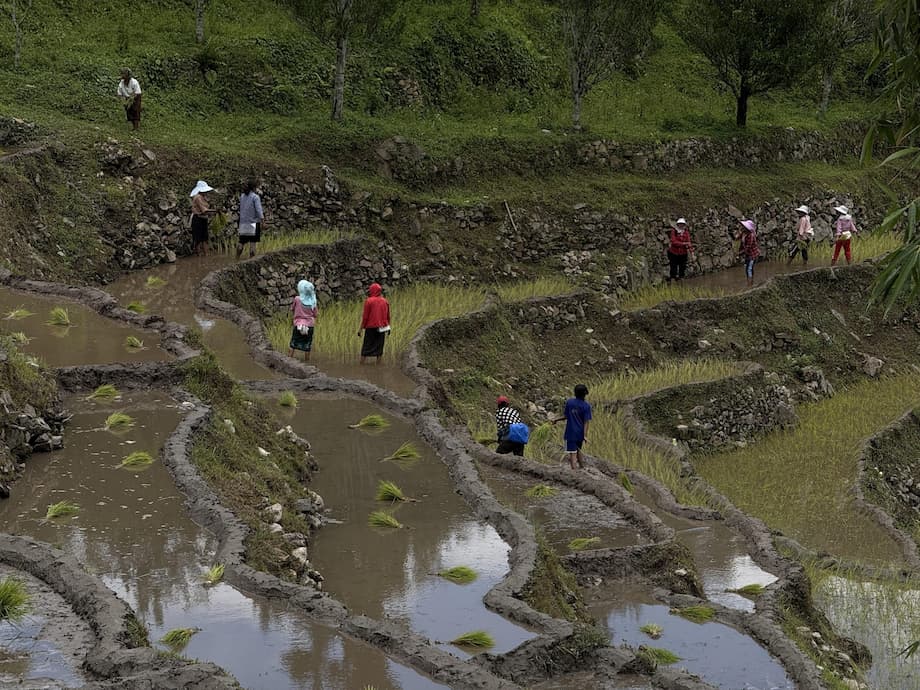A staple under pressure
Rice remains the anchor of Bhutan’s food supply, providing 53 percent of daily dietary energy. Yet domestic fields meet only 45 percent of the national requirement, and the gap is filled largely by imports from India. The latest Integrated Agriculture and Livestock Census shows how fragile the balance has become. Bhutan’s farms produced 41,537.28 metric tonnes of paddy in 2024, with irrigated paddies contributing 41,352.28 tonnes and upland paddies 185 tonnes. Irrigated output rose 1.94 percent compared with 2023, but upland paddy fell 23 percent. The mixed picture reflects deeper structural pressures on land, labor, and water.
- A staple under pressure
- What is driving the decline?
- Climate variability is reshaping the monsoon
- Disease and pests add to losses
- Water and irrigation are the critical bottleneck
- Soil fertility and seeds, the quiet constraints
- Policy choices and tradeoffs
- What could help now
- Local snapshots, rice bowls and frontier fields
- What to Know
Paddy is cultivated in all 20 dzongkhags, from tropical lowlands at roughly 200 meters above sea level to warm temperate terraces near 2,700 meters. Punakha led 2024 output with 8,027.35 tonnes, keeping its reputation as the rice bowl of Bhutan. At the other end, Pemagatshel harvested just 47 tonnes. Farmers grow a range of modern Bhutanese varieties, including Bajo Maap 1 and 2, Bajo Kaap 1 and 2, Yusi Ray Maap, and Yusi Ray Kaap. Most of what is grown is eaten locally, either by the producing households or within nearby markets.
Behind the totals is a steady contraction of the rice sector’s human footprint. The number of irrigated paddy growers fell from 23,620 in 2021 to 20,920 in 2024. Upland paddy farmers declined from 1,907 in 2020 to 825 in 2024. While total cereal production in 2024 increased 4.92 percent year on year, rice area and the farming population continue to shrink. This long term squeeze on capacity is what alarms food security planners, since rice still carries the largest cultural and dietary weight in Bhutan.
What is driving the decline?
Farmers and officials point to a common set of pressures. Rural labor is tight, younger Bhutanese are moving to towns, and many farmers are aging. Urban growth and changes in livelihoods have reduced arable plots or fragmented them into fields that are hard to irrigate and manage. Human wildlife conflict, especially crop raids by elephants and wild boars, has become more acute in several southern and eastern districts. Limited and unreliable irrigation makes matters worse, because paddies need steady water at key growth stages.
Labor and land pressures
Rice cultivation is labor intensive, from transplanting to weeding to harvest. Households that once shared tasks across extended families now face fewer hands and higher wage bills. Fragmented holdings add costs and reduce efficiency. Mechanization can ease the burden, but small scattered plots and steep terraces make it hard to use larger equipment, and many villages still lack service providers for small machines.
Wildlife conflict at the farm gate
Elephants and wild boars can destroy a season’s work in a single night. Farmers respond with night watches, scare devices, and fencing. Those measures are expensive or exhausting to maintain, and compensation systems can be slow to resolve claims. Frequent raids push some households to abandon paddies or switch to crops that are less attractive to wildlife.
Irrigation and infrastructure constraints
Rice depends on predictable water. Many canals and intakes need repair or modernization, and climate shifts have made river flows less reliable. Where irrigation is not assured, farmers cut back on rice or plant late, losing yield potential. Storage, transport, and milling infrastructure also influence decisions. Weak postharvest systems raise losses and can discourage investment in the next season.
Climate variability is reshaping the monsoon
Recent research points to rising temperatures and more erratic rainfall across Bhutan, with direct consequences for rice. An analysis of five districts found a clear warming trend and a general decline in precipitation over long records dating to 1901, along with stronger exposure to drought, flash floods, windstorms, and hail. The models used in the study forecast a continued decline in paddy and maize production in the coming decade if these patterns persist. The authors recommend climate smart agriculture (CSA) and climate smart villages as ways to build resilience, including better soil and water conservation and access to climate information services.
Flood modeling work reinforces the risk from extreme rainfall. A study of the Punatshangchu and Wangchu river basins projects that, by late century, annual rainfall magnitude could increase about 60 percent, extreme events by more than 32 percent, and flood inundation by 60 to 90 percent. Inundation depth and volume could rise up to 60 percent, with projected agricultural damage increasing two to six times and the value of losses rising much more. With many paddies concentrated in valley bottoms, heavier monsoon bursts and out of season storms raise the chance of submergence, erosion, and landslide blockage of canals. Links to these studies can be found at ScienceDirect for both basin flood projections and broader climate impacts on agriculture in Bhutan.
Disease and pests add to losses
Disease pressure compounds climate stress. Bhutan’s 1995 rice blast epidemic, caused by the fungus Pyricularia grisea, devastated traditional cultivars in several mid and high altitude zones. Scientific investigations found that weather conditions that year were unusually favorable for blast development, leading to near total losses in worst hit fields. Rice blast remains a threat when cool, humid conditions align during tillering and panicle formation. Vigilant scouting, use of tolerant or resistant varieties, balanced fertilization, and careful water management reduce risk.
Other biotic stresses include weeds competing for nutrients and moisture, and insect pests that surge in warm, dry spells or after heavy rains. Climate variability can expand the windows that favor outbreaks. Integrated pest management, coupled with timely advice and inputs, helps farmers limit losses without raising costs sharply. For background on the 1995 epidemic and lessons for disease management, a summary is available on ScienceDirect.
Water and irrigation are the critical bottleneck
An irrigated paddy can withstand short dry spells and still hit good yields. Without dependable water, yield potential drops fast. Farmers in Bhutan’s terraces often rely on gravity fed canals that share limited flows among many plots. Leaky earthen channels, blocked intakes, and storm damage to diversion structures are common. Even simple upgrades, like lining key sections of canals, repairing intakes before the monsoon, or adding small storage ponds, can stretch water across the transplanting window and reduce conflict between upstream and downstream users.
Water saving irrigation practices can help when supply is tight. Alternate wetting and drying, where fields are allowed to drain to a set depth before re flooding, cuts water use while maintaining yields when managed carefully. Good leveling, bund maintenance, and precise scheduling are needed, so extension support and local demonstrations are important. Small pumps and pipes can bridge dry spells where topography allows, but power and fuel costs limit use. Planning that combines watershed restoration, canal maintenance, and on farm efficiency can stabilize paddy water even as rains become less predictable.
Soil fertility and seeds, the quiet constraints
Soil health underpins rice productivity. Bhutanese farmers have long relied on farmyard manure, crop residues, and forest litter to maintain fertility. Studies note that access to chemical fertilizers remains uneven, and many districts face nitrogen shortfalls that cap yield. Balancing organic sources with judicious mineral inputs, where available, can lift nutrient supply, especially nitrogen and phosphorus, during the critical growth stages of rice. Extension support on timing and split applications pays off in both yield and input efficiency.
Innovations in soil amendments could help. Research highlighted by Mongabay reports yield gains from biochar, a carbon rich material produced by heating crop residues in low oxygen conditions. Trials in Bhutan and neighboring regions found improved soil health and higher yields across several crops when biochar was used in the right doses. Rice husk biochar is a candidate input in paddy areas that can secure husks from mills. Adoption is still limited by awareness and access, and excessive application can backfire, so farmer training and careful guidelines are essential. A background explainer is available from Mongabay for those interested in the approach.
Seed systems matter as well. Quality seed of locally adapted varieties improves stand vigor and disease tolerance. Bhutan has released and promoted modern rice lines such as the Bajo and Yusi varieties, but the seed supply chain can be thin, especially in remote areas. Strengthening community based seed production and certification would help farmers replace tired seed stock more often. The wider cereal picture points to shrinking cultivated area. The International Maize and Wheat Improvement Center (CIMMYT) reports that between 2016 and 2021, the area under rice in Bhutan contracted by more than half, while maize area fell even more. The drivers include urban expansion, rural migration, and climate pressures. These declines make seed access and yield improvement even more critical to stabilize food supply. Details on seed system strengthening are available from CIMMYT.
Policy choices and tradeoffs
Bhutan’s commitment to environmental protection is central to national identity. The country has explored ambitious ideas, including a complete shift to organic agriculture. Research led by Humboldt Universitat zu Berlin assessed the likely effects and found that a full conversion could reduce agricultural production by about 15 percent, with conventional farmers facing a drop in yields near one quarter, especially in rice and potatoes. The study warned that a rapid conversion would increase reliance on imported food and strain other goals like higher self sufficiency. Policymakers have since focused on a gradual and targeted approach, with 6 percent of arable land registered and 3 percent certified under local organic assurance, according to a recent ScienceDirect review of the program.
Food security policy now faces a balancing act. Agriculture accounted for 14.7 percent of GDP in 2022, but the sector has to adapt to climate and demographic change. A Development Asia insight argues that climate smart agriculture can raise productivity and resilience. This includes farmland consolidation where possible, mechanization that fits small terraces, research on new seed varieties, better water management, improved harvesting and storage, and dedicated programs to build skills among women and young people. Success will also require improved logistics, market access, and postharvest handling to reduce losses.
What could help now
Practical steps exist that fit Bhutan’s terrain and farm structure. Many have been tested in the region and can be scaled with local adaptation and strong extension support.
- Stabilize irrigation, from intake to field: repair and line priority canals, add small storage ponds, and support alternate wetting and drying where water is scarce.
- Tackle human wildlife conflict: expand community operated electric and solar fences, improve night watch systems with shared shifts, and streamline compensation to restore farmer confidence.
- Strengthen local seed systems: multiply and certify seed of adapted rice varieties, refresh seed stocks frequently, and link seed groups to district agriculture centers.
- Invest in soil fertility: promote balanced nutrient management combining organic sources with timely mineral inputs where feasible, and pilot safe, well guided use of rice husk biochar.
- Close the yield gap with tailored advice: use village based demonstrations on transplanting density, weed control, and water scheduling; provide timely weather and pest alerts through mobile services.
- Mechanize where it fits: expand access to small tillers, transplanters, and reapers that work on terraces; organize service providers so farmers can rent machines during peak periods.
- Reduce losses after harvest: improve on farm drying, storage, and local milling; activate processing centers and adopt crop specific handling manuals to cut quantity and quality losses.
- Support diversification without abandoning rice: promote vegetables, pulses, and fruits in multi tier systems to spread risk and income while keeping core paddy area productive.
- Design finance and insurance for smallholders: offer seasonal credit for inputs and water infrastructure, and pilot weather indexed cover that pays quickly after floods or droughts.
- Back research and extension: fund breeding for disease tolerant and climate resilient rice, improve disease surveillance for blast and other threats, and sustain extension visits through the season.
Local snapshots, rice bowls and frontier fields
Differences across districts are stark. Punakha’s extensive valley floors, historic irrigation works, and close access to markets help it top production tables. Upland districts with steep slopes and patchy water struggle to maintain paddies, and many families have shifted to cereals and vegetables that fit their conditions. The sharp fall in upland paddy growers, from 1,907 to 825 in four years, shows how fast marginal fields are exiting rice. That shift is rational for households, yet it narrows national capacity at a time when climate shocks can disrupt imports.
Building resilience means playing to each area’s strengths. In the rice heartlands, the priority is water and disease management, better seed, and steady mechanization. In upland areas, rice may survive in core pockets while other crops carry more weight. Programs like CARLEP have shown that diversified, market linked systems can lift income and manage risk. The goal is not to force a single model across Bhutan but to keep viable paddy areas productive, protect farmers from avoidable shocks, and give households realistic choices that support food security.
What to Know
- Rice supplies 53 percent of daily dietary energy in Bhutan, but farms produce only 45 percent of national demand.
- Bhutan harvested 41,537.28 tonnes of paddy in 2024, with irrigated output up 1.94 percent and upland paddy down 23 percent year on year.
- The number of irrigated paddy growers fell to 20,920 in 2024 from 23,620 in 2021; upland paddy growers dropped to 825 from 1,907 in 2020.
- Punakha led national output with 8,027.35 tonnes, while Pemagatshel produced 47 tonnes.
- Labor shortages, shrinking and fragmented farmland, wildlife conflict, disease pressure, and weak irrigation are main constraints.
- Studies project warmer conditions, more extreme rainfall, and higher flood risk in key basins, raising damage to rice fields.
- Fertility gaps and thin seed systems limit yields; research points to nitrogen shortfalls and opportunities for better seed and soil practices.
- A full shift to organic farming could reduce total agricultural output by about 15 percent, so gradual, targeted approaches are favored.
- Priority actions include irrigation upgrades, wildlife protection, improved seed and soil management, practical mechanization, and stronger postharvest systems.
- Climate smart agriculture, local seed production, and better extension services can help stabilize rice production and farmer incomes.
For further reading: climate smart agriculture in Bhutan at Development Asia (rel=”noopener noreferrer” href=”https://development.asia/insight/edge-food-security-promoting-climate-smart-agriculture-bhutan”), yield gap strategies at FAO (rel=”noopener noreferrer” href=”https://www.fao.org/4/x6905e/x6905e0h.htm”), rice blast history at ScienceDirect (rel=”noopener noreferrer” href=”https://www.sciencedirect.com/science/article/abs/pii/S0167880999001292″), flood risk modeling for Bhutan’s valleys at ScienceDirect (rel=”noopener noreferrer” href=”https://www.sciencedirect.com/science/article/pii/S2214581824000351″), seed system insights at CIMMYT (rel=”noopener noreferrer” href=”https://www.cimmyt.org/news/strengthening-seed-systems-emphasized-to-enhance-bhutans-seed-and-food-security-initiatives/”), and biochar background at Mongabay (rel=”noopener noreferrer” href=”https://news.mongabay.com/2024/07/biochar-could-play-big-role-in-bhutans-carbon-storage-but-its-news-to-farmers/”).




